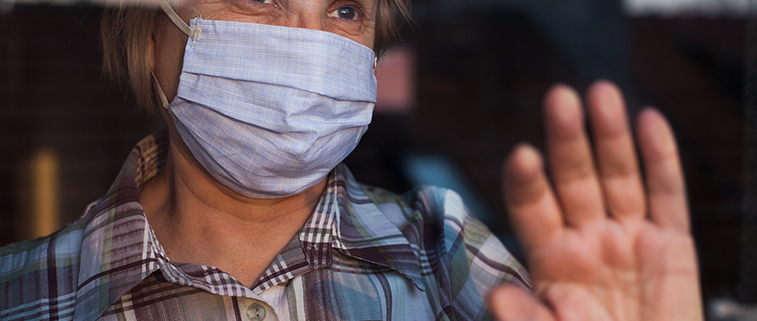The Double Pandemic Of Social Isolation And COVID-19: Cross-Sector Policy Must Address Both
The struggle to balance literal survival with all the things that make surviving worthwhile has never been so clear, with the COVID-19 pandemic forcing many to sacrifice social connections – and therefore quality of life – for life itself. And yet, as I wrote in a recent Health Affairs policy brief, Social Isolation and Health (released June 22, 2020), being socially connected in meaningful ways is actually key to human health and survival.
The COVID-19 pandemic and the need to slow the virus’ spread have highlighted the pervasiveness of social contact within, and social relevance of, nearly every sector of our lives, including employment, education, entertainment, travel, transportation, and recreation. The pandemic has also highlighted the underlying weaknesses of our current social “support systems” for older adults, students, families, workers, and at-risk populations. As such, COVID-19 has underscored the necessity of strengthening local and federal systems to rebuild and sustain the social and emotional needs of the population – a task that will be critical to the nation’s public health recovery from the pandemic.
In this post, I explain why concerns about social isolation are heightened during the pandemic; discuss why policy responses must consider the impact of reduced or changed social connection across all sectors; highlight possible unintended consequences of improved digital connection; and, emphasize the importance of prioritizing social needs in recovery efforts.
Population-Wide Social Isolation Due To COVID-19
While social isolation and loneliness were prevalent in the population prior to COVID-19, efforts to reduce the virus’ spread via stay-at-home orders, quarantine, and social distancing recommendations have exacerbated an already serious problem. With the exception of “essential workers,” the pandemic has meant limiting physical proximity to those with whom one lives. For the 28 percent of Americans who live alone, this has meant little to no human contact for months. Regardless of living situation, interactions with anyone outside the home have been severely limited for everyone. Preliminary surveys suggest that within the first month of COVID-19, loneliness increased by 20 to 30 percent, and emotional distress tripled. While several surveys are still ongoing to capture the full extent of the problem, current evidence suggests the pre-existing public health crisis of social isolation and loneliness may be far more widespread than previously estimated.
In addition, older adults, people of color, those with low income, and those in congregate living centers (e.g., nursing homes and prisons) have been disproportionately victims of COVID-19. These populations were already at high risk for poor health outcomes, social isolation, and loneliness. Pandemic-related inequities in access to resources compound this risk. For example, the prevalence of loneliness is higher among low-income individuals, who may be less able to work remotely and subsequently more likely to lose employment.
Social Isolation Carries Long-Term And Immediate Risks To Survival
With a highly infectious and deadly novel virus, why should we care about social isolation and loneliness? As described in my brief, robust evidence links social isolation to increased risk of death from all causes and increased morbidity across a variety of physical health outcomes. These well-established risks are a result of chronic effects over time. Thus, understandably, restrictions associated with the immediate risks of the coronavirus were prioritized for public health. Nonetheless social isolation and loneliness do have immediate effects that are health-relevant that should not be ignored.
The increase in distress due to social distancing that many Americans are experiencing is a normal response. Given that humans are a social species, this is our biology signaling a need to reconnect socially, just like hunger signals us to eat, and thirst signals us to drink water. Proximity to others, particularly trusted others, signals safety. When we lack proximity to trusted others our brain and body may respond with a state of heightened alert. This can result in increases in blood pressure, stress hormones, and inflammatory responses—which if experienced on an ongoing basis can put us at increased risk for a variety of chronic illnesses. Among those with pre-existing health conditions, these changes in physiology could potentially exacerbate the condition, precipitate the onset of an acute event, or hasten disease progression.
Immediate effects of social isolation related to the pandemic have already been observed, with surges in mental health concerns, substance abuse, and domestic violence. Early observation suggests problematic health behaviors, including substance use, poorer sleep, and emotional or overeating, may increase. Further, more than two million Americans purchased guns during the month of March (the second highest monthly total in the decades since such records have been kept), raising concerns for increased risk for suicide. Both short-term and long-term public health concerns will emerge if steps are not taken to mitigate these effects.
Social Contact Is A Key Component Of Every Sector
The pandemic has shown the world how fundamental social contact is in our lives, as almost every aspect of life has changed to create social distance. These social distancing efforts have led to remote working; remote or online education; cancellation of sporting, entertainment, and professional events; and, closures of museums, parks, churches and much more. Going forward, we are likely to see sustained changes to the way we live, work, and play, and even in the way we age. In fact, we have already seen calls for permanent changes in social norms, policies and physical environments– all of which are social determinants of health. The Centers for Disease Control define the social determinants of health as “the conditions in which people are born, grow, live, work and age, as well as the complex, interrelated social structures and economic systems that shape these conditions.” The substantial changes in our social behavior as a result of this pandemic are clearly far-reaching, but we do not yet know what lingering longer-term public health effects the pandemic may foreshadow. If the prevalence rates of social isolation and loneliness remain elevated or increase, such changes are likely to lead to a greater public health burden in the longer term.
I proposed in my brief that we use a “social in all policy” framework to address social isolation and loneliness. This approach remains just as, if not more, important in light of COVID-19. Indeed, the social relevance of every sector is now more readily apparent. Changes to each of these sectors can either promote or deter social connection. Therefore, caution and ongoing evaluation are needed. Reactionary policy could potentially ignore the long-term public health costs of social isolation and loneliness, creating changes that lead to permanent increases in distance and isolation. Policies that create greater isolation to curb the virus’ spread should be considered temporary, and novel social approaches should be explored for more permanent or long-term policy.
Addressing The Digital And Social Divides
Maintaining connections to others outside the home during the quarantine has increased our reliance upon phones and digital technologies. Of course, reliance on technology was rapidly increasing prior to the pandemic, but with increasing demand for telehealth, telework, and online education, issues of connectivity and the digital divide have been catapulted to the forefront of many policy discussions. Access to the internet is more crucial than ever, but we must pause to ask the bigger question: what is the full scope of consequences that may result from scaling digital capabilities and solutions?
While digital tools have clear benefits, including the capability to provide access to information and resources and bridge distances, there are potential tradeoffs. It is unclear to what extent digital tools approximate the human experience of in-person contact, or whether our biological needs for human connection can be satisfied through such tools. There is some evidence of a “loneliness paradox” wherein tech and social media that should make us more socially connected actually increase loneliness. In addition, the pandemic has highlighted limitations of video conferencing tools that go beyond Zoom Fatigue. For example, anyone who has attended a virtual funeral or wedding, or even just a virtual happy hour, realizes that it may be better than nothing but feels drastically inadequate. According to one survey, these virtual social gatherings failed to reduce loneliness among 48 percent, and actually increased loneliness among 10 percent of respondents. Permanent scaling of digital solutions may create a different kind of digital divide, such that human contact becomes a luxuryexacerbating economic disparities.
Whether a digital solution is specifically aimed at social isolation and loneliness or is employed to address other issues (e.g., remote secondary education), there may be social consequences to such solutions. Any sector transitioning to digital or remote modes of operation, and any policy that promotes or funds such transitions, should simultaneously require (and fund) evaluation of its effectiveness across social outcomes, not just access and productivity. This moment provides us an opportunity to address digital market failures and longstanding inequities in access and to evaluate the safety and effectiveness of digital based solutions.
Social Needs Must Be Prioritized In Pandemic And Recovery Policy
Concerns about the secondary ramifications of the pandemic have focused nearly exclusively on a global economic recession. There should be similar concerns of a social recession. Similar to an economic recession that can have lasting effects even after the economy begins to grow, the social restrictions put in place during the pandemic may have profound long-term consequences, even after restrictions are lifted.
Social isolation and loneliness can also influence our economic recovery. A recent AARP study found social isolation among older adults is associated with 6.7 billion in annual Medicare spending. The true economic burden of loneliness is likely much larger, given that it has also been linked to greater workplace absenteeism, lower productivity, and lower quality of work. Thus, if social needs are not met, the economic burden post-COVID-19 may be greater.
Recently the Coalition to End Social Isolation and Loneliness made the following policy recommendations: (1) Maintain and improve access to mental and behavioral health services that mediate the mental health implications of social isolation and loneliness for vulnerable populations; (2) Improve the public health response to COVID-19 and widespread social isolation and loneliness; (3) Provide for additional targeted funding for programs and services under the Older Americans Act; and (4) Enhance supports for our nation’s education system to combat the effects of social isolation and loneliness for our now displaced students. These are a good start, but as described in my brief and here, social isolation has broader implications for policy. Drawing on the “Social in All Policy” framework proposed in my brief, we must consider social ramifications across sectors of health, transportation, housing, employment, nutrition, water, and sanitation. This global pandemic may yet provide an important opportunity to redraft policy so as to alleviate further social isolation.
As we move forward in our “new normal,” individual and stakeholder decision-making should be based on scientific evidence of benefits and drawbacks to our well-being, not solely on economic costs and convenience. Accordingly, we will need evidence-based guidance, and that means a focus on science in both our public discourse and in institutional funding. A full understanding of the effects of COVID-19-related social isolation and loneliness on both short- and long-term public health will require rigorous study. Further, as adaptations to the pandemic across sectors are shifting and may become permanent, the need for action and evaluation of such practices and policies becomes more urgent. It is clear that no single organization or sector can solve this issue alone. Thus it is critical to establish and fund a National Resource Center to centralize evidence, resources, training, and best practices.
Now is the time to study the costs of human loneliness. Our future health depends on encouraging and maintaining greater social connection.







